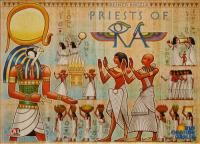Review: Priests of Ra
Posted by James (admin) on November 13th, 2009
 Priests of Ra is based on the classic game Ra, also by Reiner Knizia. I shall be reviewing Priests of Ra as if not having played the original game because not everyone has played the original game and it is important to see it for the game it is and not just the comparison. I’ll add comparisons separately at the end.
Priests of Ra is based on the classic game Ra, also by Reiner Knizia. I shall be reviewing Priests of Ra as if not having played the original game because not everyone has played the original game and it is important to see it for the game it is and not just the comparison. I’ll add comparisons separately at the end.
Priests of Ra is a bidding and tile collection game played over three epochs (rounds). Players are aiming to score the most victory points which are scored by collecting different sets of tiles. Players bid for tiles using their three bidding stones and each stone has a unique number on it from 1 to 15. The rules describe which specific bidding stones each player should start with so that it is fair. (Note that not all tiles get used depending upon the number of players.) In the centre is the board which has two important tracks: the auction track and the Ra track, plus there is a single bidding stone. Next to the board is a bag of tiles which each represent priests, temples, warriors, pestilence, Ra and more.
On a player’s turn, they can either take a tile from the bag and add it to the auction track, or they can invoke Ra. If they take a tile from the bag, and it is not a Ra tile, their turn is over. If a Ra tile is drawn, it is placed on the Ra track and an auction for the tiles on the auction track begins. No one has to bid and, if there are no bids at all, it is simply the next player’s turn. If a player invokes Ra, an auction begins for the tiles already on the auction track but in this case (and very importantly) the player who invoked Ra *must* bid if everyone else passes.
Players bid in auctions using one of their remaining bidding stones which are always face-up so all players know what stones the other players may potentially bid. The player that wins the auction, takes the tiles they won plus the bidding stone already on the board and then places the bidding stone they successfully bid with in the middle of the board. The stone they have just taken can not be used until the next epoch which means the stones that players use each epoch will be different.
When the Ra track is full of Ra tiles, the epoch ends immediately (which can be tough luck for any players who have not used all three of their bidding stones) and players score points for different collections of tiles. Some tiles are removed, but some tiles remain and accumulate for scoring at the end of the game only. Pestilence tiles score negative points.
Priests of Ra is a game with a lot of thinking because there are many hidden facets to each area. The central mechanic of the auctions contains a lot more decisions than you would expect. As you would expect, you need to assess how much you may want the tiles but the amount of different ways to score makes this quite complicated. In addition, you can see what the other players may or may not bid. Plus, it may be advantageous to use a low-number bidding stone to get fewer tiles but with a high-number bidding stone so you’re in a stronger position in the next epoch. Whether to invoke Ra or draw a tile is similarly more interesting than it seems because there are other factors that will influence your decision based on the stones you have left, the status of the Ra track, and so on.
There are a lot of different ways to score points. In fact, my only real criticism of the game is that there may be too many ways which makes it confusing when trying to work out what gaining some tiles really means to your potential score.
So, what’s it like compared to the original Ra? Well, it’s not much different apart from the different scoring methods and different types of tiles (which are double-sided). In that way, even though Ra and Priests of Ra are both good games for those who like difficult decisions and depth of thinking, I was a bit disappointed with Priests of Ra because I had hoped for more difference. They’re so similar (even down to the points tiles and bidding stones) that I can’t see why a player would need both in their collection.
To that point, there seemed to be quite a few re-workings of old games at Essen this year like Cable Car (Metro), Granada (Alhambra) and Priests of Ra (Ra). These are all good games and are great for players who have not played the originals before, but they don’t really add enough to warrant a purchase for those who already own/know them.
I enjoyed Priests of Ra and, if you haven’t played Ra before, you will like it if you like bidding with some good thinking. If you played Ra before then you know what to expect with some different scoring methods.
James
[Played with 4 players]
Second Opinion: Read the thoughts of the other player (my friend Rick) at: http://www.gamesetupmatch.com/news.htm#10

